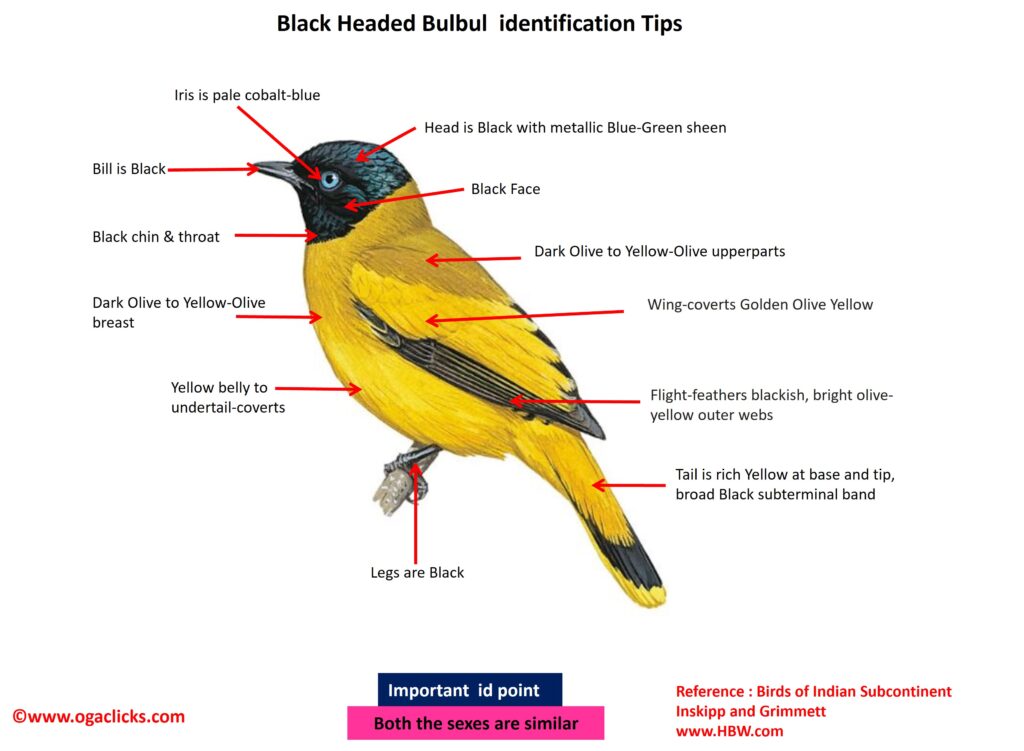
Black Headed Bulbul Pycnonotus atriceps
Etymology:
- Pycnonotus : Greek word puknos thick, compact; notos –backed { thick backed}
- Atriceps: Latin word ater-black; ceps –capped { Black Capped}
Vernacular Names: Cachar: Dao-bulip-garaju (grey phase), Dao-bulip-garasha (normal phase), Hindi: Kala sir Bulbul
Distribution in India: Resident of Himalayas
Description: Size of 16–18 cm; wt. of 20–30 g. It is a small, active, brightly coloured bulbul with very small legs. The head is black with metallic blue-green sheen; upperparts are dark olive to yellow-olive, feathers of lower back and rump are bright yellow with blackish bases (strongly barred effect when raised or ruffled), long uppertail-coverts are bright yellow. The rounded tail is rich yellow at base and tip, broad black subterminal band; wings are blackish, bright olive-yellow outer webs of secondaries and tertials forming large solid panel on inner wing, contrasting with black primaries (two-toned effect. The breast and flanks are dark olive to yellow-olive, rest of underparts are bright yellow. The plumage colour individually is variable, some birds are with greenish wash overall, others brighter yellow. The iris is pale cobalt-blue (often looks white at distance); bill is black; legs are brownish black or dusky. It has a rare grey morph that has slaty neck, breast and belly, with vent, undertail-coverts and inner wing variably yellowish or white. Both the sexes are alike. The juvenile is much duller, with less pronounced wing pattern, dark olive or brownish head and throat, yellow parts of plumage darker and greener, base of rump feathers brown; feathers of uppertail-coverts and undertail-coverts are shorter, iris is brownish or dull bluish grey.
Habitat: It is found in broadleaf evergreen forest, mixed deciduous forest, and peatswamp-forest, often where open and at edges along roads, clearings, waterways, etc.; occurs also in second growth, mature tree orchards and plantations in vicinity of natural habitat, bamboo, canebrakes, wooded gardens, scattered trees in grassland, back mangroves, and well-developed coastal scrub. It is found from 400–m to 1600 m.
Food Habits: It eats fruits like figs and invertebrates like dragon flies & beatles. The ripe fruit is picked from bushes and trees. It does aerial-sallying for flying insects, often darts out, catches prey, and returns to same or nearby perch; also gleans small amount of invertebrate food from branches. It is usually inconspicuous, but restless; in pairs or small parties moving through tall trees, often also in midstorey or lower at edges.
Breeding Habits: They breed in Jan–Sept. They nest singly or in loose clumps of pairs. The nest is a loosely constructed open cup, made of tough creeper stems and twigs interwoven with few blades of coarse grass, often with outer layer of dead leaves, and lined with fine grass stems; placed in bush or tree, often in upright fork or cane fronds. They lay a clutch of 1–3 eggs. Both parents tend the nestlings and fledglings.